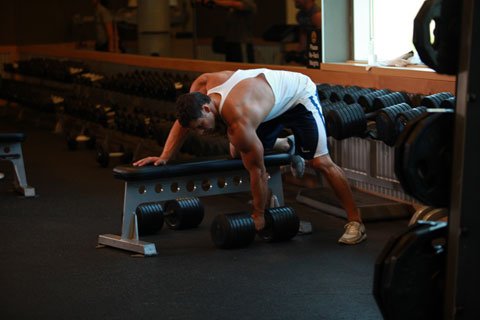There is a lot of information out there about the best way to gain muscle mass. It can be confusing. I decided to look for the best information I could find in articles from scientific journals. Here is what I came up with.
Resistance Training And Hypertrophy
Studies have shown that high volume resistance training incorporating short inter-set rest periods produces significant short-term elevations in human growth hormone (HGH) following the completion of resistance training exercise 4,5,7.
Based upon these studies, high volume/short rest resistance training has been accepted as the gold standard in resistance training for muscular hypertrophy. Unfortunately, despite HGH’s well known anabolic role, none of the aforementioned studies examined whether or not high volume training actually produced superior hypertrophy, rather, hormonal changes were observed in isolation.
Studies that did directly examine the effect of resistance training volume on muscular hypertrophy found that low volume resistance training produced comparable hypertrophy to high volume resistance training6,8. Two other studies showed that when training volume was held constant, longer rest periods did not cause a decrement to the hypertrophic response1,2.

Low Volume Training Produced Comparable
Hypertrophy To High Volume Training.
Training Volume And Hormonal Response
In terms of post-exercise elevations in Testosterone levels, low volume resistance training produced elevations similar to those produced by high volume resistance training4,5,7. With training volume held constant, shorter rest periods did not result in a greater post-exercise testosterone elevation1.
Low volume resistance training has also been shown to produce significant post-exercise elevations in insulin-like growth factor-1 (IGF-1)3,4. More research must be done to determine if acute elevations of IGF-1 correspond to chronic hypertrophy.
After reviewing the aforementioned literature, some conclusions can be drawn. High volume/short rest resistance training produces larger post-exercise increases in HGH than low volume resistance training.
Low volume and/or high rest resistance training can produce hypertrophy comparable to that of high volume/short rest resistance training. Both low volume and high volume resistance training incorporating inter-set rest periods of varying lengths can produce significant post-exercise increases in testosterone levels.
More research should be done to determine whether short-term hormonal changes following resistance training correlate directly to chronic muscle hypertrophy. Future research should look at each of the anabolic hormones, testosterone, HGH, and IGF-1 independently as resistance training appears to affect each differently.
Elevations in testosterone are important to hypertrophy as studies have linked increases in testosterone levels with increases in muscle cross-sectional area (CSA)1,6.
Conversely, elevations of HGH and IGF-1 do not appear to have been directly correlated to hypertrophy.
 High Volume/Short Rest Training Produces
High Volume/Short Rest Training ProducesLarger Post-Exercise Increases In HGH.
References:
- Ahtiainen, J. P., Pakarinen, A., Alen, M., Kraemer, W. J., & Hakkinen, K. (2005). Short vs. long rest period between the sets in hypertrophic resistance training: influence on muscle strength, size, and hormonal adaptations in trained men. Journal of Strength and Conditioning Research, 572-582.
- Campos, G. E. R., Luecke, T. J., Wendeln, H. K., Toma, K., Hagerman, F. C., Murray, T. F., Ragg, K. E., Ratamess, N. A., Kraemer, W. J., & Staron, R. S. (2002). Muscular adaptations in response to three different resistance-training regimens: specificity of repetition maximum training zones. European Journal of Applied Physiology, 50-60.
- Kostka, T., Patricot, M. C., Mathian, B., Lacour, J., & Bonnefoy, M. (2003). Anabolic and catabolic hormonal responses to experimental two-set low-volume resistance exercise in sedentary and active elderly people. Aging Clinical and Experimental Research, 123-130.
- Kraemer, W. J., Marchitelli, L., Gordon, S. E., Harman, E., Dziados, J. E., Mello, R., Frykman, P., McCurry, D., & Fleck, S. J. (1990). Hormonal and growth factor responses to heavy resistance exercise protocols. Journal of Applied Physiology, 1442-1450.
- Kraemer, W. J., Gordon, S.E., Fleck, S. J., Marchitelli, L. J., Mello, R., Dziados, J.E., Friedl, K., Harman, E., Maresh, C., & Fry, A.C. (1991). Endogenous anabolic hormonal and growth factor responses to heavy resistance exercise in males and females. International Journal of Sports Medicine, 228-325.
- Ostrowski, K. J., Wilson, G.J., Weatherby, R., Murphy, P. W., Lyttle, A. D. (1997). The effect of weight training volume on hormonal output and muscular size and function. Journal of Strength and Conditioning Research, 148-154.
- Smilios, I., Pilianidis, T., Karamouzis, M., & Tokmakidis, S. P. (2003). Hormonal responses after varied resistance exercise protocols. Medicine & Science in Sports & Exercise, 644-654. Retrieved March 4, 2007, from Ovid database.
- Starkey, D. B., Pollock, M. L., Ishida, Y., Welsch, M. A., Brechue, W. F., Graves, J.E., & Feigenbaum, M. S. (1996). Effect of resistance training volume on strength and muscle thickness. Medicine & Science in Sports & Exercise, 644-654. Retrieved February 27, 2007, from Ovid database.
